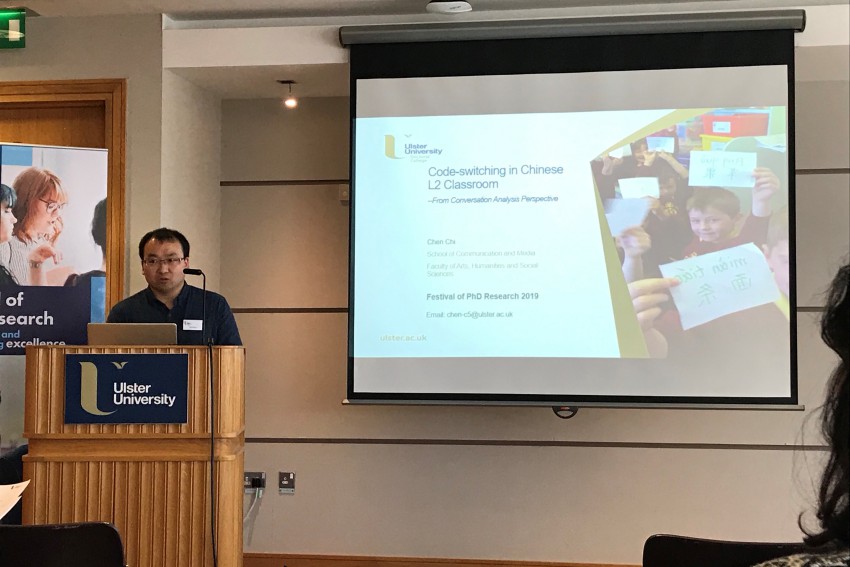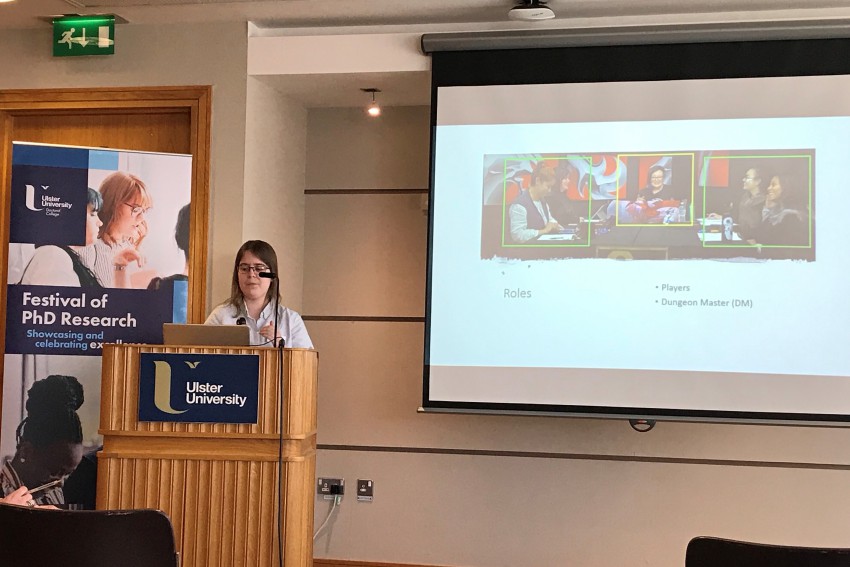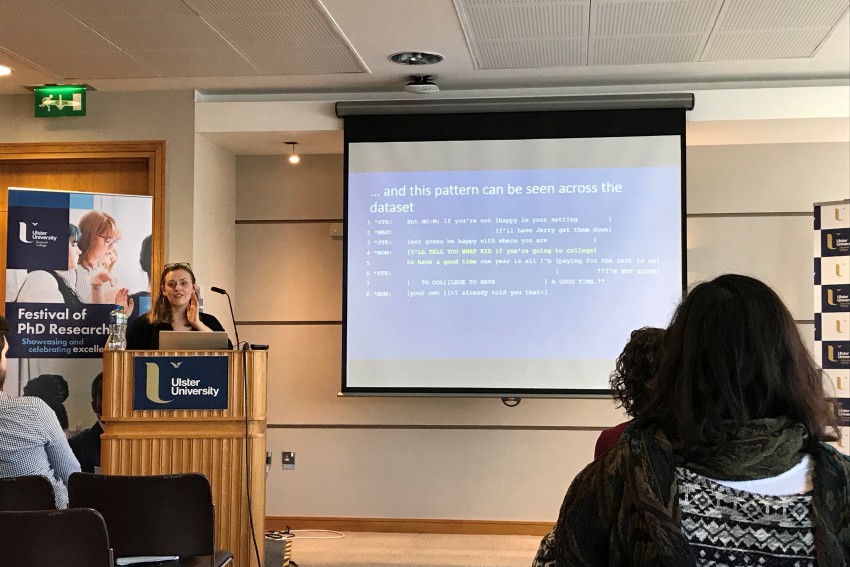Three PhD students from the Modern Languages and Linguistics unit presented their research at the Festival of PhD Research in Jordanstown on 10 April 2019.
-
Chen Chi - Code Switching in Chinese L2 Classroom
 Code-switching refers to the phenomenon where language users with two or more languages (or dialects) switch between languages in communication.
Code-switching refers to the phenomenon where language users with two or more languages (or dialects) switch between languages in communication.Recent research has witnessed discussion of code-switching from the angle of Conversation Analysis. Auer (1998) and Li (2002) argue that code-switching should be elaborated from the participant’s angle in talk-in-interaction, and the interpretation of code-switching is dependent on sequential position. Auer (1995) clarifies discourse-related code-switching and participant-related code-switching, with the latter a reflection of the negotiation between the participants on language selection. Li and Milroy (1995) argue the occurrence of code-switching in two sequential organizations, one is preference organization in adjacency pairs and another in repair sequences. Code-switching in classroom discourse takes place during the interaction between teacher and student or among students themselves. Code-switching in classroom communication has been on the radar of many researchers, there is a considerable literature on code-switching, whilst little attention had been paid to this by analysis of L2 classroom interaction through the lens of Conversation Analysis.
This paper draws on conversation analysis to examine code-switching in classroom interaction where Chinese is taught as a foreign language. The data is drawn from the Confucius classroom in Northern Ireland, and then transcribed and analysed using Conversation Analysis to shed some light on the interactional practices in these L2 classes. The analysis focuses on the sequential properties of the teacher’s code-switches from English to Chinese, especially the relevance of the post expansion sequential position for the code-switching in relation to the communicative abilities of the local pupils. The study depicts the organization of code-switching which is initiated by the teacher and that the code-switching is orderly practised to promote student’s L2 communicative abilities.
-
Samantha Finlay - Interaction Analysis of Storytelling in Roleplaying Games
 Using Conversation Analysis, this project analyses social interaction in roleplaying games (RPGs). This presentation focuses on one aspect of this study and discusses how participants use their orientation to knowledge as a practice for conducting roleplay, and how this affects the relationship between roleplay and storytelling. Speakers design their talk relative to their recipients (recipient design), and as such, will not tell them something they already know (Sacks 1995). However, while playing RPGs such as Dungeons and Dragons, participants often tell stories to recipients who already know them. This is because these knowing participants are roleplaying as relatively unknowing characters. During roleplay, participants will design their talk relative to the characters they roleplay as, and as such, will orient to their character’s knowledge instead of what they know as players. Therefore, participants use their orientation to character knowledge as a practice for recognisably producing roleplay, and orient to this practice when telling stories during the roleplay.
Using Conversation Analysis, this project analyses social interaction in roleplaying games (RPGs). This presentation focuses on one aspect of this study and discusses how participants use their orientation to knowledge as a practice for conducting roleplay, and how this affects the relationship between roleplay and storytelling. Speakers design their talk relative to their recipients (recipient design), and as such, will not tell them something they already know (Sacks 1995). However, while playing RPGs such as Dungeons and Dragons, participants often tell stories to recipients who already know them. This is because these knowing participants are roleplaying as relatively unknowing characters. During roleplay, participants will design their talk relative to the characters they roleplay as, and as such, will orient to their character’s knowledge instead of what they know as players. Therefore, participants use their orientation to character knowledge as a practice for recognisably producing roleplay, and orient to this practice when telling stories during the roleplay.Sacks, H. (1995) Lectures in Conversation Analysis Volume I & II. Oxford, Blackwell.
-
Natalie Flint - How to avoid compliance without defiance: a study of threats in family interaction
 This presentation is part of a broader project on resistance in family interactions, however in this talk the focus is exclusively on resistance to threats. When a first action is produced, a fitted (or ‘aligned’) response is made relevant. In the case of threats, when a threat has been issued the fitted response options are to comply or defy (Hepburn & Potter 2011). This paper explores resistance as a disaligned next turn (see Kent 2011; 2012). Resistance is an alternative to responding to an action which allows non-compliance with the action, but without explicitly being defiant. In the family interactions presented in this talk, threat recipients do not explicitly defy threats, but instead, they resist compliance with them.
This presentation is part of a broader project on resistance in family interactions, however in this talk the focus is exclusively on resistance to threats. When a first action is produced, a fitted (or ‘aligned’) response is made relevant. In the case of threats, when a threat has been issued the fitted response options are to comply or defy (Hepburn & Potter 2011). This paper explores resistance as a disaligned next turn (see Kent 2011; 2012). Resistance is an alternative to responding to an action which allows non-compliance with the action, but without explicitly being defiant. In the family interactions presented in this talk, threat recipients do not explicitly defy threats, but instead, they resist compliance with them.This talk examines how threat recipients use resistance to avoid compliance by exploring the relationship between linguistic structure and action formation in producing and resisting threats. Through the analysis of the design on the turn, the sequential organisation of the threat sequence, the sequential context, and the context of the interaction, we can see how interactants are able to identify actions-in-progress and resist compliance, in some cases before the first component of the threat is complete.
Natalie Flint also received an award for the best presentation of the day. Congratulations to Natalie and thanks to everyone who helped make the event a success.


